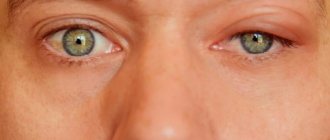Contraindications
The use of eye drops is prohibited if you have a history of the following conditions:
- hypersensitivity to any components of the drug;
- childhood;
- bearing a child and lactation period;
- allergic rhinitis;
- bronchial asthma;
- hyperchloremic acidosis;
- angle-closure glaucoma;
- obstructive pulmonary disease;
- sinus bradycardia;
- heart failure.
If the patient is undergoing surgery in which general anesthesia will be used, Azarga should be discontinued 2 days before the expected date of surgery.
Combined eye drops should be used with caution in the presence of the following pathologies:
- hyperthyroidism;
- diabetes;
- pigmentary and pseudoexfoliative glaucoma;
- Prinzmetal's angina;
- blood flow disturbance;
- decreased intraocular pressure.
Side effects
The active components of the drug can be absorbed into the bloodstream, so systemic side effects may develop. In 10% of cases, the following symptoms may appear:
- development of irritation and pain in the eyes;
- the appearance of a feeling of the presence of a foreign body;
- blurred vision.
In 0.1 – 1% of patients the following symptoms appear:
- clouding or swelling of the cornea;
- dry eyes;
- development of allergic conjunctivitis, redness, itching and burning;
- inflammatory processes in the eyelids;
- increased intraocular pressure;
- decreased visual acuity;
- increased sensitivity to light;
- presence of scleral pigmentation;
- development of dry keratoconjunctivitis;
- double vision;
- increased lacrimation;
- constriction of the pupil;
- apathy;
- sleep disturbance, nightmares;
- development of chronic respiratory diseases;
- a sore throat;
- cough;
- hair loss, in some cases lichen planus develops;
- nervous disorders, depression;
- memory loss;
- drowsiness.
To reduce the risk of systemic absorption, it is recommended to apply gentle pressure on the inner corner of the eye for 2-3 seconds after instilling Azarga.
Directions for use and dosage
Azarga is applied topically. Shake the bottle before use.
The drug is prescribed 1 drop into the conjunctival sac of the eye 2 times a day.
To reduce the risk of developing systemic side effects after instillation, it is recommended to gently press your finger on the projection area of the lacrimal sacs at the inner corner of the eye for 1-2 minutes (this reduces systemic absorption of the drug).
If you miss the next instillation, you must continue using the drug from the next dose in accordance with the schedule. Do not exceed the recommended daily dose.
If you have previously used another antiglaucoma drug, Azarga should be started the day after discontinuation of the previous drug.
Interaction with other drugs
The simultaneous use of Azarga with cardiac glycosides, Guanetedine, and calcium channel blockers is not recommended. This is due to the possibility of slowing heart rate and lowering blood pressure.
Simultaneous use with cimetidine and quinidine leads to the development of bradycardia. The use of Azarga during therapy with carbonic anhydrase inhibitors causes increased side effects.
Combined eye drops are prescribed with caution when treating with Clotrimazole, Treoleandomycin, Itraconazole, and Ketoconazole.
Simultaneous use of Azarga with hypoglycemic drugs leads to a strong decrease in glucose levels in the bloodstream. Co-administration of the drug with other eye drops requires maintaining an interval of 15 minutes between drugs.
Azarga eye drops: instructions for use
Azarga is based on two active compounds: brinzolamide and timolol. The first of these is a carbonic anhydrase II inhibitor, which helps reduce the production of intraocular fluid.
The second substance (beta-adrenergic receptor blocker) slightly increases the outflow of moisture and also reduces its production. Symbiosis in one bottle enhances the effect of both components, resulting in eye pressure drops.
The main indications for the use of Azarga are hypertension and open-angle glaucoma.
Glaucoma
The following are used as minor ingredients:
- benzalkonium chloride in the form of a solution;
- mannitol;
- sodium chloride;
- purified water;
- disodium edetate;
- tyloxapol;
- sodium hydroxide.
Since Azarga is a combination of 2 active substances at once, its use is usually prescribed when individual drugs or their analogues have not given the expected result.
special instructions
Prescribing Azarga to elderly patients may cause a decrease in concentration. If a patient uses drops while wearing contact lenses or has corneal abnormalities, then it is necessary to monitor the condition of the membrane. This allows you to prevent malnutrition of the cornea of the eye.
It is recommended to remove contact lenses before using Azarga; they can be reinstalled only after 15 minutes.
The drug is stored in a dark place at a temperature of no more than 250 C. The shelf life of eye drops is 2 years, after opening the solution can be used for 30 days. Before using the drug, the bottle should be shaken vigorously. To prevent contamination of the solution, you must avoid touching the tip of the bottle and the eye tissue.
Analogues of the drug Azarga
Patients leave positive reviews about the combination drug. However, an important disadvantage of the drug is its high cost (price varies from 860 to 1200 rubles per bottle) and hypersensitivity to the components of Azarga. In such cases, the prescription of analogue drugs is required:
- Timolol;
- Azopt;
- Xalatan;
- Travatan;
- Pilocarpine;
- Betoptik;
- Kosopt;
- Trusopt;
- Okumed;
- Arutimol.
Only an ophthalmologist can replace the drug.
Azarga is an effective combination drug that is used to reduce intraocular pressure. The medicine is usually well tolerated, but in some cases the development of local and systemic side effects is noted.
Brinarga
Systemic effects. Brinzolamide and timolol may be subject to systemic absorption. Timolol, when applied topically, can cause the same adverse reactions from the cardiovascular and respiratory systems, as well as other undesirable reactions, as systemic beta-blockers.
Hypersensitivity reactions, characteristic of all sulfonamide derivatives, may develop when using the drug Brynarga due to systemic absorption. If serious adverse reactions or hypersensitivity reactions occur, the drug should be discontinued.
Cardiac disorders. In patients with cardiovascular disease (eg, coronary artery disease, Prinzmetal's angina, heart failure) and hypotension, beta-blocker therapy should be critically evaluated and treatment with other active agents considered. Patients with cardiovascular disease should be closely monitored for signs of exacerbation of the disease and adverse reactions.
Vascular disorders. Caution should be used in patients with severe impairment/disorder of peripheral circulation (Raynaud's disease or severe Raynaud's syndrome).
Hyperthyroidism. β-blockers may mask the symptoms of hyperthyroidism.
Muscle weakness. β-blockers have been reported to increase muscle weakness that occurs with some symptoms of myasthenia gravis (eg, diplopia, ptosis, and general weakness).
Respiratory system disorders. Respiratory reactions, including death from bronchospasm, have been reported in patients with asthma after taking topical beta-blockers.
Hypoglycemia/diabetes. β-blockers should be prescribed with caution to patients with a tendency to spontaneous hypoglycemia or patients suffering from labile diabetes, since these drugs may mask the symptoms of acute hypoglycemia.
Acid-base imbalance. The development of acid-base imbalance with the use of oral forms of carbonic anhydrase inhibitors has been described. In patients at risk of renal failure, the drug should be used with caution due to the possible risk of metabolic acidosis.
Concentration of attention. Oral carbonic anhydrase inhibitors may affect the ability to perform activities requiring increased alertness and/or physical coordination in elderly patients. These phenomena can be observed because brinzolamide penetrates into the systemic circulation when applied topically.
Anaphylactic reactions. Patients with atopy or a history of severe anaphylactic reactions to various allergens who are receiving beta-blockers may react more severely to exposure to these allergens and may also be resistant to normal doses of epinephrine for the treatment of anaphylactic reactions.
Detachment of the choroid of the eye. Cases of detachment of the choroid have been described when using drugs that prevent the formation of intraocular fluid (for example, timolol, acetazolamide) after filtering operations.
Surgical anesthesia. The action of β-blockers in ophthalmic drugs can block the systemic action of β-agonists, for example, epinephrine. The anesthesiologist should be informed that the patient is taking timolol.
Concomitant therapy. When using the drug Brynarga in patients taking systemic beta-blockers, it is necessary to take into account the possible mutual enhancement of the pharmacological action of the drugs, both in relation to the known systemic effects of beta-blockers and in relation to the reduction of intraocular pressure.
Careful monitoring of such patients is necessary.
The combined use of two local β-blockers is not recommended. There is a potential for increased systemic effects resulting from carbonic anhydrase inhibition in patients taking oral carbonic anhydrase inhibitors and Brynarga. The simultaneous administration of Brynarga and oral carbonic anhydrase inhibitors is not recommended.
Effects on the organ of vision. The effect of brinzolamide on corneal endothelial function in patients with corneal disorders (especially patients with low endothelial cell counts) has not been studied. Contact lens wearers should be closely monitored for corneal health while using brinzolamide as carbonic anhydrase inhibitors may affect corneal hydration. Close monitoring of patients with corneal disorders, such as patients with diabetes mellitus or corneal dystrophy, is recommended.
Benzalkonium chloride. Benzalkonium chloride, which is part of the drug Brinarga, can cause eye irritation and also change the color of soft contact lenses. Contact with soft contact lenses should be avoided.
Before using the drug, contact lenses should be removed and put back no earlier than 15 minutes after using the drug.
Brynarga contains benzalkonium chloride, which may cause punctate keratopathy and/or toxic ulcerative keratopathy. With long-term use of the drug, patients should be carefully monitored.
Liver dysfunction. Brynarga should be used with caution in patients with severe hepatic impairment.
Impact on the ability to drive vehicles and machinery:
Brynarga has a minor effect on the ability to drive and operate machinery.
If the patient experiences temporary blurred vision after using the drug, it is not recommended to drive a car or engage in activities that require increased attention and reaction until it recovers.
Carbonic anhydrase inhibitors may impair the ability to perform tasks requiring concentration and/or coordination.











